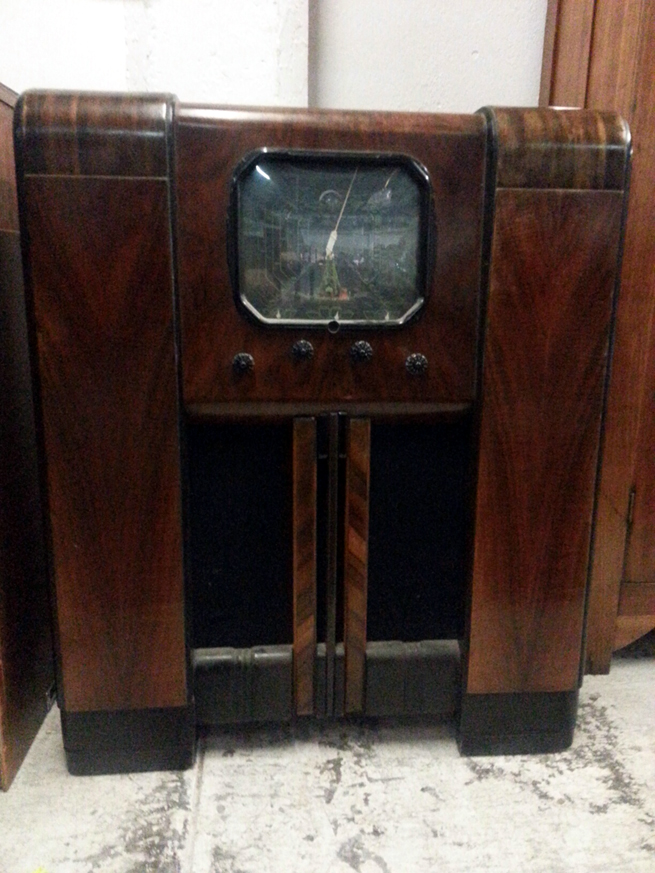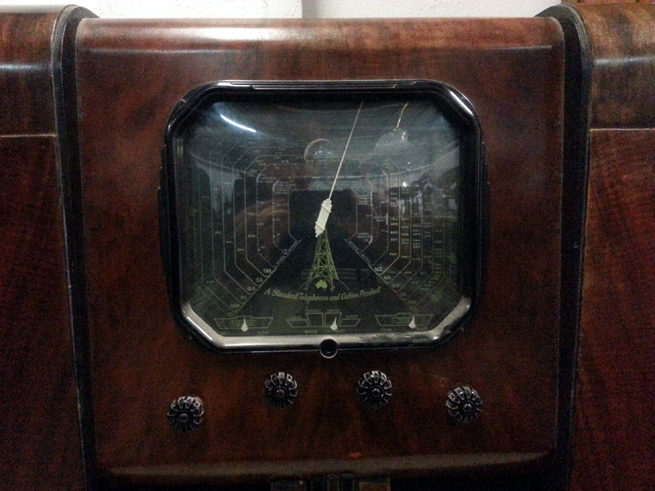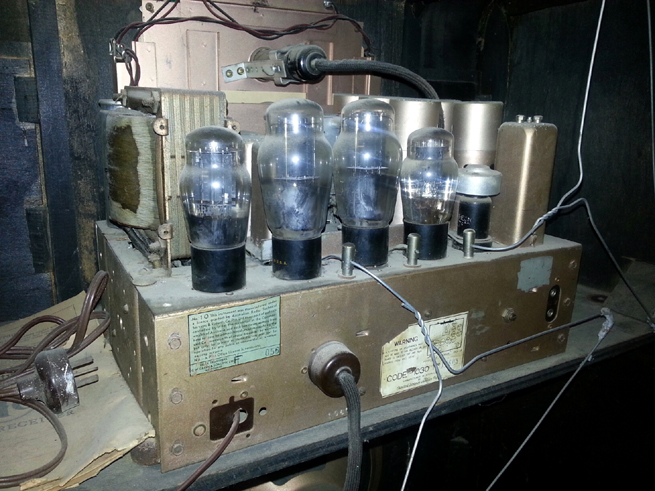General Discussion
Forum home - Go back to General discussion
|
Model No. of STC
|
|
|
Return to top of page · Post #: 1 · Written at 11:13:44 AM on 11 August 2013.
|
|
|
|
Location: Adelaide, SA
Member since 11 August 2013 Member #: 1393 Postcount: 12 |
|
I am a complete novice, who has just purchased his first radio, and I have been trying to identify exactly what it is?    |
|
|
Return to top of page · Post #: 2 · Written at 11:56:38 AM on 11 August 2013.
|
|
|
|
Location: Cameron Park, NSW
Member since 5 November 2010 Member #: 770 Postcount: 426 |
|
STC had a model 1030 in their 1939 range, a 10 valve, 3 band set, with magic eye tuning. |
|
|
Return to top of page · Post #: 3 · Written at 1:21:07 PM on 11 August 2013.
|
|
|
|
Location: Adelaide, SA
Member since 11 August 2013 Member #: 1393 Postcount: 12 |
|
I think it would be referred to as a Tombstone type, from reading this site. The legs are the bottom of the sides which look like square columns, and they just continue to the ground. It sits a couple of inches off the ground. |
|
|
Return to top of page · Post #: 4 · Written at 3:13:17 PM on 11 August 2013.
|
|
|
|
Location: Cameron Park, NSW
Member since 5 November 2010 Member #: 770 Postcount: 426 |
|
Could you send a photo to Brad, the site administrator, as in note 6 of the instructions on the page bottom. |
|
|
Return to top of page · Post #: 5 · Written at 3:24:24 PM on 11 August 2013.
|
|
|
|
Location: NSW
Member since 10 June 2010 Member #: 681 Postcount: 1379 |
|
With the introduction of automatic gain control it was difficult to tune a radio accurately just from listening to the sound alone. This led to the introduction of visual tuning indicators of which the magic eye tube is one. |
|
|
Return to top of page · Post #: 6 · Written at 5:16:50 PM on 11 August 2013.
|
|
|
|
Location: Melbourne, VIC
Member since 20 September 2011 Member #: 1009 Postcount: 1257 |
|
This STC "code" 1030, with its RF stage and push-pull 6A3 output, was the top of the range, ultra deluxe STC model for 1939. It would of been a very expensive radio in its day. From memory I think the STC's had a multi-layered dial glass with a hole for the magic-eye. You did not mention if this radio has been restored electrically or not. If it hasn't been restored, it would be a major project to get it up & running again, but would be worth it. And as per prior post, please don't be tempted to fire it up, if unrestored, as you could damage hard to find components. |
|
|
Return to top of page · Post #: 7 · Written at 5:56:48 PM on 11 August 2013.
|
|
|
|
Location: NSW
Member since 10 June 2010 Member #: 681 Postcount: 1379 |
They do, with the added advantage that you can if necessary repaint it yourself, as the dial markings are etched into the glass. So to repaint, clean off the old markings (after noting carefully the colours), repaint, dry and scrape off the excess with a razor. I was able to do this to my 830 (made in 1938); however the feature may not be general to all examples. It is not for the 632, another 1939 radio as is the 1030. So make sure the glass is etched for the markings before scraping off them off! |
|
|
Return to top of page · Post #: 8 · Written at 6:20:04 PM on 11 August 2013.
|
|
|
|
Location: Adelaide, SA
Member since 11 August 2013 Member #: 1393 Postcount: 12 |
|
I will email a photo. Too late for not turning it on though. I already did and it works great! I will have a look if it glows. |
|
|
Return to top of page · Post #: 9 · Written at 6:33:00 PM on 11 August 2013.
|
|
|
|
Location: Sydney, NSW
Member since 28 January 2011 Member #: 823 Postcount: 6899 |
|
So has anybody got an idea of the value? I'm still a bit worried I got ripped off, because I knew nothing about it when I bought it. I just thought it was a handsome object. |
|
|
Return to top of page · Post #: 10 · Written at 10:16:28 PM on 11 August 2013.
|
|
|
|
Location: Melbourne, VIC
Member since 20 September 2011 Member #: 1009 Postcount: 1257 |
|
As GTC says, the value of this radio today is subjective and depends on many factors. |
|
|
Return to top of page · Post #: 11 · Written at 10:24:39 AM on 12 August 2013.
|
|
|
|
Location: NSW
Member since 10 June 2010 Member #: 681 Postcount: 1379 |
|
Regarding the 6T5, I have noticed in the past new old stock examples of this valve selling on eBay for over $100. |
|
|
Return to top of page · Post #: 12 · Written at 10:42:15 AM on 12 August 2013.
|
|
|
|
Location: Adelaide, SA
Member since 11 August 2013 Member #: 1393 Postcount: 12 |
|
Thanks to Monochrome 625 for the link. |
|
|
Return to top of page · Post #: 13 · Written at 12:53:28 PM on 12 August 2013.
|
|
|
|
Location: Cameron Park, NSW
Member since 5 November 2010 Member #: 770 Postcount: 426 |
|
There will probably be a terminal on the chassis or a wire coming out a hole at the rear of the chassis, marked "Aerial" or simply "A". In a metropolitan area, a metre or two of wire connected to the radio terminal or chassis wire will be enough to bring in your local stations. |
|
|
Return to top of page · Post #: 14 · Written at 3:25:20 PM on 12 August 2013.
|
|
|
|
Location: NSW
Member since 10 June 2010 Member #: 681 Postcount: 1379 |
|
Looking at the circuit diagrams, the 1030 earth arrangement is the same as the 830. |
|
|
Return to top of page · Post #: 15 · Written at 1:54:53 PM on 13 August 2013.
|
|
|
|
Location: NSW
Member since 10 June 2010 Member #: 681 Postcount: 1379 |
|
Looking at the photo of the chassis, the 1030 differs from the 830 in that the 1030 has a third (right hand) spring terminal connected to the chassis (the other two have insulating washers under them). |
|
|
You need to be a member to post comments on this forum.
|
|

Sign In

Vintage Radio and Television is proudly brought to you by an era where things were built with pride and made to last.
DISCLAIMER: Valve radios and televisions contain voltages that can deliver lethal shocks. You should not attempt to work on a valve radio or other electrical appliances unless you know exactly what you are doing and have gained some experience with electronics and working around high voltages. The owner, administrators and staff of Vintage Radio & Television will accept no liability for any damage, injury or loss of life that comes as a result of your use or mis-use of information on this website. Please read our Safety Warning before using this website.
WARNING: Under no circumstances should you ever apply power to a vintage radio, television or other electrical appliance you have acquired without first having it checked and serviced by an experienced person. Also, at no time should any appliance be connected to an electricity supply if the power cord is damaged. If in doubt, do not apply power.
Shintara - Keepin' It Real · VileSilencer - Maintain The Rage
